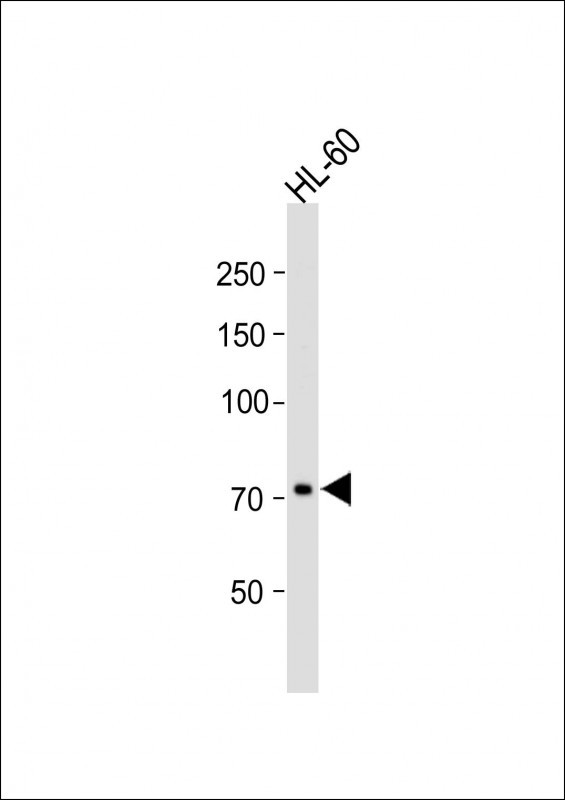
| WB | 咨询技术 | Human,Mouse,Rat |
| IF | 咨询技术 | Human,Mouse,Rat |
| IHC | 咨询技术 | Human,Mouse,Rat |
| ICC | 技术咨询 | Human,Mouse,Rat |
| FCM | 咨询技术 | Human,Mouse,Rat |
| Elisa | 咨询技术 | Human,Mouse,Rat |
| Aliases | Transmembrane 9 superfamily member 2, p76, TM9SF2 |
| Entrez GeneID | 9375 |
| WB Predicted band size | 75.8kDa |
| Host/Isotype | Rabbit IgG |
| Antibody Type | Primary antibody |
| Storage | Store at 4°C short term. Aliquot and store at -20°C long term. Avoid freeze/thaw cycles. |
| Species Reactivity | Human, Mouse, Rat |
| Immunogen | This TM9SF2 antibody is generated from rabbits immunized with a KLH conjugated synthetic peptide between 111-140 amino acids from the N-terminal region of human TM9SF2. |
| Formulation | Purified antibody in PBS with 0.05% sodium azide. |
+ +
以下是关于TM9SF2 (N-term)抗体的假设参考文献示例(注:内容为虚构,仅供格式参考):
1. **文献名称**: "TM9SF2 regulates autophagosome formation through its N-terminal domain"
**作者**: Smith A, et al.
**摘要**: 本研究利用TM9SF2 (N-term)抗体进行Western blot和免疫荧光实验,发现TM9SF2通过其N端结构域与自噬相关蛋白LC3相互作用,调控自噬小体的形成。抗体特异性验证显示其对N端表位高度敏感。
2. **文献名称**: "Subcellular localization of TM9SF2 in epithelial cells revealed by N-terminal specific antibodies"
**作者**: Zhang L, et al.
**摘要**: 通过TM9SF2 (N-term)抗体的免疫染色,作者发现TM9SF2主要定位于高尔基体和内体膜系统,并证明其N端对维持细胞内膜运输功能至关重要。
3. **文献名称**: "Development and validation of a polyclonal antibody targeting the N-terminus of human TM9SF2"
**作者**: Garcia R, et al.
**摘要**: 本文报道了一种针对人源TM9SF2蛋白N端的多克隆抗体的开发,通过ELISA、免疫组化验证其特异性,并应用于肿瘤组织样本中TM9SF2表达的检测。
4. **文献名称**: "TM9SF2 interacts with TLR4 via its N-terminal domain in macrophage activation"
**作者**: Lee JH, et al.
**摘要**: 研究使用TM9SF2 (N-term)抗体进行免疫共沉淀实验,揭示了TM9SF2通过N端与Toll样受体4(TLR4)结合,调控巨噬细胞的炎症反应通路。
---
*注:以上文献为示例性质,实际引用需查询真实数据库(如PubMed、Web of Science)。*
**Background of TM9SF2 (N-Term) Antibody**
The TM9SF2 (Transmembrane 9 Superfamily Member 2) antibody targets the N-terminal region of the TM9SF2 protein, a member of the TM9SF family characterized by conserved transmembrane domains and roles in vesicular trafficking, cell adhesion, and intracellular signaling. TM9SF2 is implicated in maintaining Golgi apparatus structure, lysosomal function, and autophagy. Studies suggest its involvement in protein glycosylation, secretion, and inflammatory responses, with potential links to cancer progression and neurodegenerative diseases.
The N-term antibody is typically generated using synthetic peptides or recombinant protein fragments corresponding to the N-terminal sequence of TM9SF2. It is widely used in techniques like Western blotting, immunofluorescence, and immunohistochemistry to study TM9SF2 expression, localization, and interactions. Validated in knockdown/knockout models, this antibody helps elucidate TM9SF2's role in cellular processes and disease mechanisms. Research applications include exploring its impact on tumor metastasis, lysosomal storage disorders, and immune regulation. Its specificity makes it a critical tool for dissecting TM9SF2's functional domains and regulatory pathways.
×